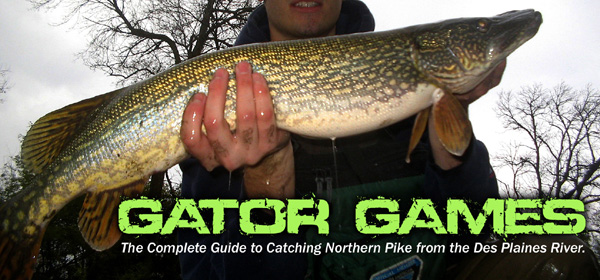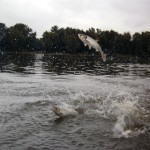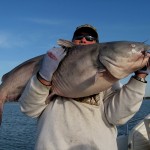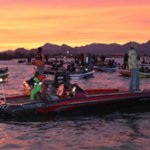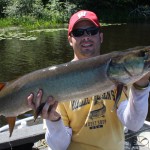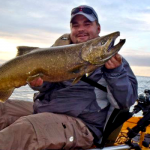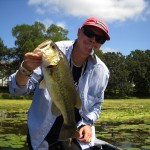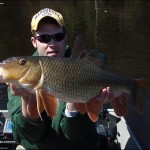By: Andrew Ragas – Date Posted: November 3, 2010
Esox Lucius, better referred to as Northern Pike, are sleek and explosive ambush predators that are popular amongst freshwater anglers. Northern Pike are coolwater species that are extremely adaptable living in a diverse number of habitats ranging from small creeks and streams to the largest river systems and lakes. The best Pike fishing in North America is typically found throughout the Midwest and northern regions of the United States, and includes much of its native range in Canada, and other non-indigenous regions.
Although most avid anglers choose to spend hundreds, if not, thousands of dollars to travel to the best Pike fishing destinations in the world in order to get that “trip of a lifetime”, there are other good alternatives for fishing success. These options can be local and close to home, extremely cost-efficient, and don’t require week-long vacations from work and other obligations. If you happen to be a resident of northern Illinois, you are in luck.
Look no further than minutes west of the city limits of Chicago, Illinois.
Flowing southward from Wisconsin through the counties of Lake, Cook, DuPage, and Will, the slow-flowing and low-turbid Des Plaines River offers some of the finest untouched and unpressured fishing that the Chicagoland area and Northeast Illinois region has to offer. More than twenty years ago, fishermen would have been hard-pressed to find such a diverse number of fish species present in this river as pollution and abuse from previous generations took their toll on the river and its fishery. However, thanks to rehabilitation and improved management of the fishery, excessive stocking efforts, and strict environmental and water quality regulations, the river has come back to life and is experiencing a revival.
Most notably of all species of fish, including the popular Walleye, Sauger, and both Largemouth & Smallmouth Bass, the Northern Pike population has flourished in recent years. Tremendous angling opportunities await for anglers who are willing to explore the waterway and are able to invest the time as the legendary explorers, Father Marquette and Louis Jolliet, once did 350 years ago.
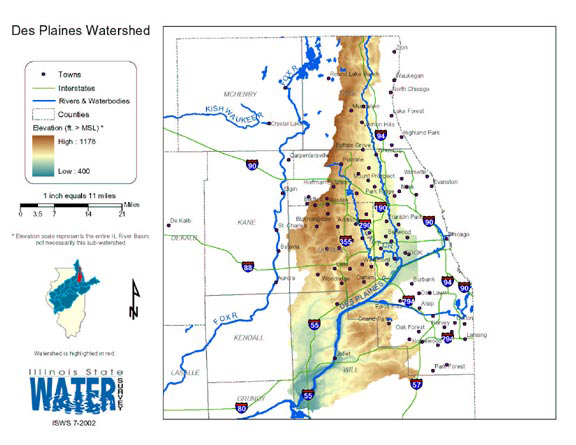
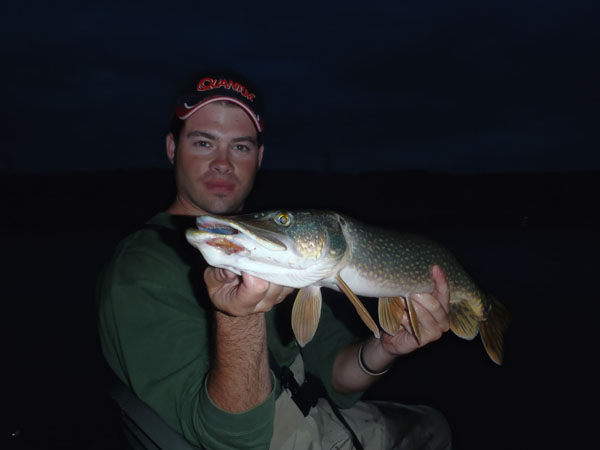
On the Des Plaines River and its connecting tributaries, Northern Pike are available in both numbers, and moderate to potentially trophy sizes. Much of the high population density is comprised of mature 20 to 30-inch fish that keep everyone interested. Understanding that there is always a good chance for a serious gator approaching the 40-inch mark often brings anglers back to the river for more as each day may result in the possibility of eventually catching bigger and better fish.
Northern Pike can be caught year-round on the Des Plaines, with the best seasonal periods occurring in spring from the end of March through the end of May, and resuming once again during the fall, lasting throughout all of October and deep into November. During these periods, typical water temperatures range anywhere from 45 to 65 degrees. It is during this time when most fish are active and feeding heavily on anything that gets caught up in their way. Besides spring and fall, other productive windows may be found at around ice-out, as fish congregate in shallow and marshy bays and backwaters; about a week-long period.
Fishing for Pike on the Des Plaines is not a hard chore as abundant fish can be caught from literally everywhere as long as there is some form of river access to them. However, if larger-sized fish greater than 30-inches are on the agenda, take note, as some homework is involved.
First and foremost, determine whether or not you are a shoreline fisherman, wader, or a boat angler. Stay within your skill level and be sure you know your individual limitations. Much of the river is accessible for shoreline anglers, but you are very limited for the amount of water you can cover as well as having a variety of casting angles. For waders, the river offers an infinite amount of productive fishing areas, but along with the good aspects come a lot of bad as wading can be difficult due to a countless number of underwater hazards, dark water clarity, and unknown, unseen, and unmarked deep pools. For instance, there have been a handful of times where my friends and I have gotten stuck and taken spills in deep non-wadeable water, and have even nearly sank in shoreline mud as proficient as quicksand. As far as boating is concerned, the river is perfect for small craft such as canoes, jon boats, and prams with electric motors. With watercraft, you can access almost every spot including inaccessible deeper holes and channel areas that are ten feet deep or more. However, the river offers poor navigation for larger boats with outboards due to large stretches of shallow water with exposed hazards, and poor launching facilities.
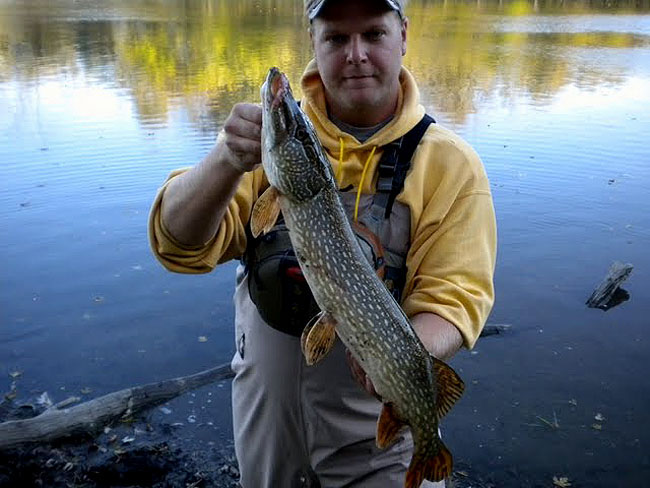
As an avid angler who has been fishing the Des Plaines and its tributaries often for the past five seasons, I have learned to adapt. I eventually find myself within all three categories in one way or another as I enjoy walking, and wading the shallower waters, and schedule float trips on weekends to otherwise inaccessible stretches of water with my friends.
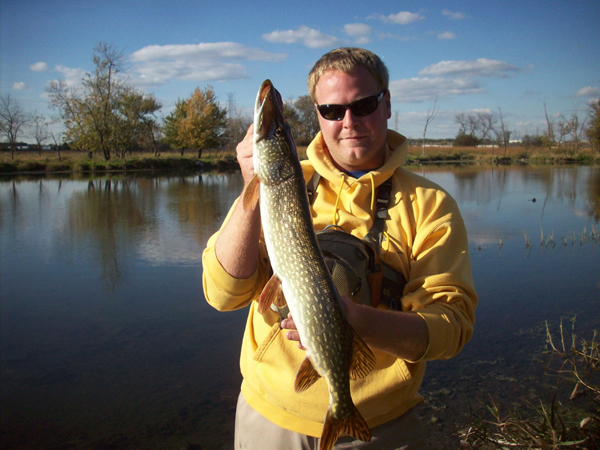
No matter how you fish the Des Plaines, there are certain key factors that will enable you to catch fish year-round. The most important is to understand location and seasonal movements as both will be dictated by water temperatures. By nature, big Pike thrive in the coolest environments they can find, and whenever they are on the move, they often do it for a purpose: To hunt prey, seek refuge and sanctuary, and mark territory. Therefore, adapt yourself to where the fish might be found on a seasonal basis.
For the greatest odds in catching fish, the best course of action is to stay mobile and cover a diverse assortment of areas. Based on personal experience, the most successful places for both numbers and larger fish occurs the farthest away from urban areas, and away from spots that receive the highest amounts of angling pressure.
However, successful river anglers tend to focus on the following areas regardless of surroundings: Bridges, as they usually offer deeper, dark pools; Log-jams, stump fields, and laydowns, because they are fish magnets in general and Pike are excellent at blending in with their surroundings; Weedbeds because they serve as fish communities; Main river channels and edges; Deep shoreline and mid-river pools; Creek arms, points, rock piles, and sandbars; Creek mouths, ditches, and other inflows; Dams (for blocked fish that have nowhere else to go); Deep current runs and slackwater pools (eddies); and backwaters and shallow coves which are best during early season outings.
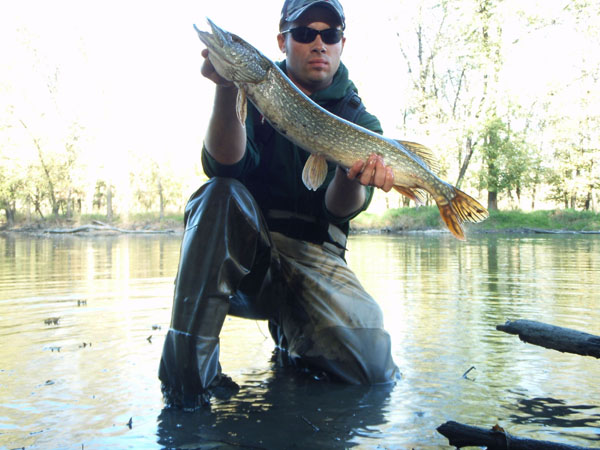
There are a variety of presentations that will work successfully. When fishing for Pike, keep in mind, however, that certain baits and lures will offer better results than others. It is important to always match the hatch, and pay attention to the patterns and movements of pelagic baitfish because wherever you find the baitfish, there will often be Pike close nearby. The dominant forage species on the Des Plaines are White Sucker, Creek Chub, Golden Shiner, Spotfin Shiner, Threadfin Shad, and assorted juvenile Sunfish species.
By keeping the forage base in mind, there are a number of productive lures that can be fished. Lure selection will always be dictated by several factors such as water clarity, water temperatures, depth, the type of cover, and moods of fish.
Due to the dark brown water clarity of the river during the spring and summertime months, it is often best to use bright and dark colored lures that offer excellent color contrast while in the water. Meanwhile, as water gets colder during the fall and winter months, clarity improves tremendously, and neutral, more natural colors will work best. Lastly, keep in mind that much of the river is full of underwater snags. Therefore, presentations that avoid bottom contact should be used most often. Lure sizes should always be determined by the feeding activity of fish and whether you intend on catching numbers of smaller fish, or entirely larger ones. To improve your odds in catching bigger fish, we often like to “go big, or go home.”
Some favorites for year-round Pike consist of the following:
- Bucktails and inline spinners with number-3, 4, 5, and 6 blades: Mepps Musky Killers, Musky Mayhem Showgirls (single), and the new single and double-bladed Sims Spinners brand are a few blades worth consideration.
- Spinnerbaits: Brand doesn’t seem to matter, but blade style and colors play an important role. Oversize double Colorado and Willow blades that generate the most vibration have produced the best results. As far as colors are concerned, black/orange, gold/white, white/red, white/silver, and bright chartreuse and orange work extremely well throughout the entire year. Use 3/8 oz to 1 oz sizes. The addition of plastic trailers such as a grub or reaper tail, and hooks, improves odds.
- Buzzbaits and topwaters: These work exceptionally well during the summer months during low water periods and when fish are tight to shore. Color doesn’t matter.
- Jerkbaits and twitch baits: 4 to 8 inch baits that fit this category are Rapala X-Raps, Husky Jerks, and Bomber Minnows. In addition, smaller Musky-sized baits such as Musky Mania Jakes and Grandmas also work well too. Color selections should be determined by water clarity and the forage base.
- Gliders and sub-surface lures: These are extremely underrated for Pike as not many anglers are accustomed to using them around Chicago. Smaller five and six inch models such as the Savage-Gear Freestyler, and any ordinary glidebait designed for Musky fishing will work. Glide baits work exceptionally well during the colder months in water temperatures below 55-degrees when fish begin utilizing the deeper channels and pools.
- Crankbaits and Rattlebaits: Due to the high shad and shiner populations, cranks and rattles can be year-round producers. Shallow and mid-range crankbaits, and rattlebaits with neutral and chrome patterns work best.
- Chatterbaits: In any color, and usually ½ oz. in size, these are great early spring and summertime producers when fish move shallow, and are using the weedlines.
- Swimbaits: Nothing better than using something molded out of soft plastic to imitate the real thing. Favorites are 4 and 5-inch Storm WildEye swim shads, Live Shiners, and Live Perch baits. In addition, Kickin’ Minnows also fare well.
- Live bait: When all else fails, drifting suckers and shiners beneath a float through the deeper holes and slackwater areas cannot be beat. Best in winter and cold water months.
As far as gear and tackle is concerned, rods and reels should be a personal choice and left entirely up to the angler himself. However, some recommendations are to use six and a half to seven and a half foot, medium-heavy action baitcasting equipment with reels spooled with 30 to 50lb. braided line. Spiderwire Stealth and Power Pro are some personal line choices. Any ordinary bass fishing gear also works well as long as the rod has sufficient length and backbone for powerful casting, hook-sets, and playing fish out of heavy cover and current. Monofilaments and copolymer lines are not ideal choices for Pike fishing, especially on moving water, due to its stretching capabilities, poor abrasion resistance, and abilities to snap.
In addition to using the proper rod and reel, be sure to carry a supply of 30 to 60lb titanium, seven-strand, or fluorocarbon leaders. It is always better to be safe than sorry as nothing is worse than having a fish bite off and swim away with a lure in its mouth. For other precautions and to ensure a safe and successful release of your catch, it is equally as important to carry the necessary release tools such as longnose pliers, jaw spreaders, and hook cutters. However, the biggest mistake any angler can make is being unaware of how to properly handle the catch. Consequently, these tools and recommendations will only simplify things and make it easier on both the fish and yourself.
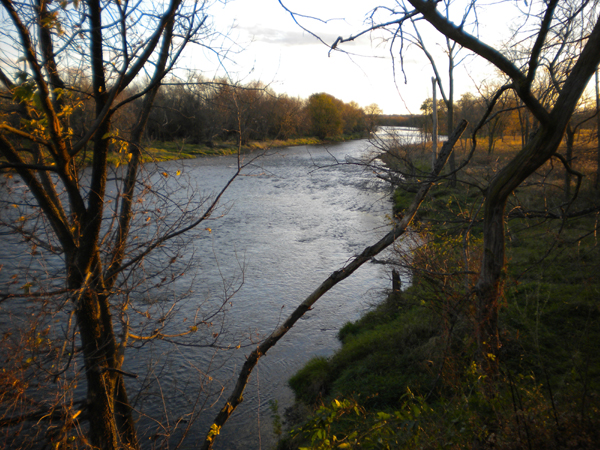
Ultimately, the Des Plaines River is an environment that encompasses all of the characteristics that a traditional and productive Northern Pike resource has to offer. The next time you are planning a Pike fishing trip, keep in mind that big money won’t have to be spent, vacation time won’t have to be taken, and individual travel times to the spot will not take long. There is a great fishing resource right next to the urban sprawl of Chicago, and within everyone’s backyards. The quality of fishing on the Des Plaines is as great as it has ever been and to this day, continues to get better. The best plan of action right now is to fish and enjoy all that is available.



